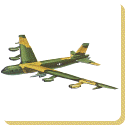 B-52 Stratofortress — The Boeing B-52 Stratofortress is a long-range, subsonic, jet-powered strategic bomber. The B-52 was designed and built by Boeing, who have continued to provide support and upgrades. It has been operated by the United States Air Force (USAF) since the 1950s. The bomber carries up to 70,000 pounds (32,000 kg) of weapons.
B-52 Stratofortress — The Boeing B-52 Stratofortress is a long-range, subsonic, jet-powered strategic bomber. The B-52 was designed and built by Boeing, who have continued to provide support and upgrades. It has been operated by the United States Air Force (USAF) since the 1950s. The bomber carries up to 70,000 pounds (32,000 kg) of weapons.
Beginning with the successful contract bid on 5 June 1946, the B-52 design evolved from a straight-wing aircraft powered by six turboprop engines to the final prototype YB-52 with eight turbojet engines and swept wings. The B-52 took its maiden flight in April 1952. Built to carry nuclear weapons for Cold War-era deterrence missions, the B-52 Stratofortress replaced the Convair B-36. Although a veteran of a number of wars, the Stratofortress has dropped only conventional munitions in combat. Its Stratofortress name is rarely used outside of official contexts; it has been referred to by Air Force personnel as the BUFF (Big Ugly Fat/Flying Fucker/Fellow).
The B-52 has been in active service with the USAF since 1955. The bombers flew under the Strategic Air Command (SAC) until it was disestablished in 1992 and its aircraft absorbed into the Air Combat Command (ACC); in 2010 all B-52 Stratofortreses were transferred from the ACC to the new Air Force Global Strike Command (AFGSC). Superior performance at high subsonic speeds and relatively low operating costs have kept the B-52 in service despite the advent of later aircraft, including the Mach 3 North American XB-70 Valkyrie, the variable-geometry Rockwell B-1B Lancer, and the stealthy Northrop Grumman B-2 Spirit. The B-52 marked its 50th anniversary of continuous service with its original operator in 2005.
History
Although the B-52A was the first production variant, the aircraft were used only in testing. The first operational version was the B-52B which had been in development in parallel with the prototypes since 1951, first flying in December 1954. The B-52B number 52-8711 entered operational service with 93rd Heavy Bombardment Wing at Castle Air Force Base, California, on 29 June 1955. The wing became operational on 12 March 1956. The training for B-52 crews consisted of five weeks of ground school and four weeks of flying, accumulating 35-50 hours in the air. The new B-52Bs replaced operational B-36s on a one-to-one basis.
Early operations were complicated by lack of spares and ground facilities while ramps and taxiways deteriorated under the weight of the aircraft. The fuel system was prone to leaks and icing, and bombing and fire control computers were unreliable. The two-story cockpit presented a unique climate control problem – the pilots’ cockpit was heated by sunlight while the observer and the navigator on the bottom deck sat on the ice cold floor. Thus, comfortable temperature setting for the pilots caused the other crew members to freeze, while comfortable temperature for the bottom crew caused the pilots to overheat. The J57 engines were still new and unreliable. Alternator failure caused the first fatal B-52 crash in February 1956, which resulted in a brief grounding of the fleet. B-52s were grounded again in July because of fuel and hydraulic system problems. To avoid maintenance problems, the Air Force set up Sky Speed teams of 50 maintenance contractors at each B-52 base. In addition to maintenance, the teams performed routine checkups which took one week per airplane.
 Kids Portal For Parents India Kids Network
Kids Portal For Parents India Kids Network
